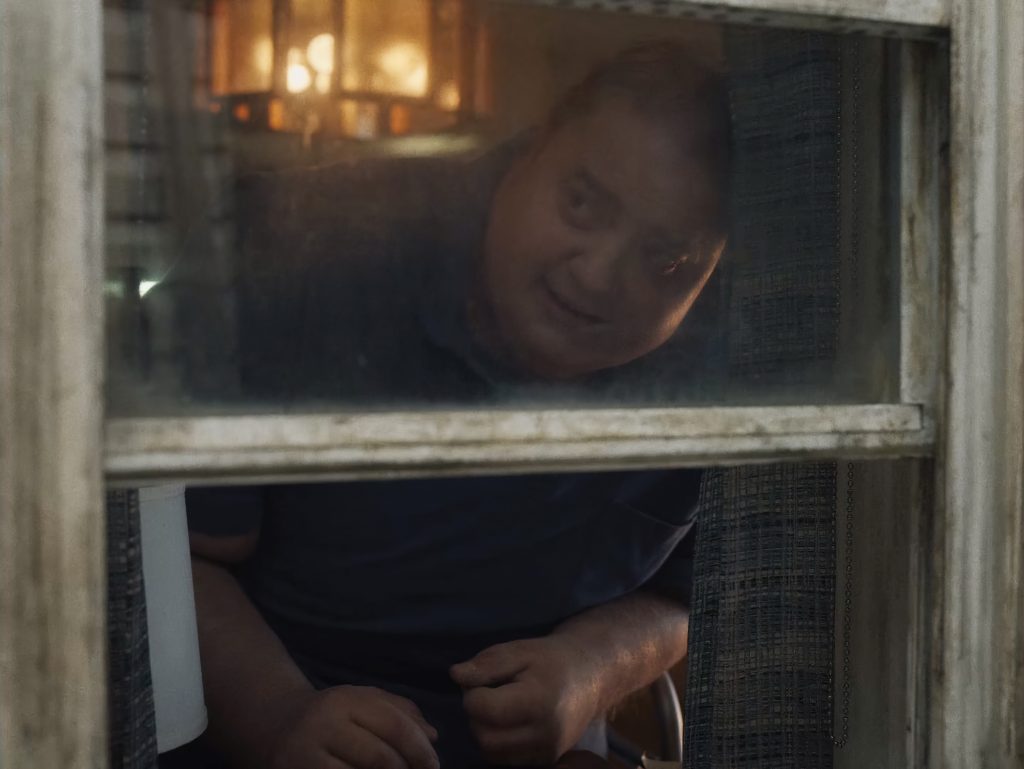
Directed by: Darren Aronofsky
Written by: Samuel D. Hunter (based on his play)
Cast: Brendan Fraser, Sadie Sink, Hong Chau, Ty Simpkins, Samantha Morton
The Whale centers around Charlie, an overweight man who lives alone. It is clear he prefers to be alone but is constantly forced to interact with people throughout the film. Each additional character is introduced during a time of need for Charlie.
Chau’s character, Liz arrives often to bring him food and check on his health. Sadie Sink plays Charlie’s daughter, Ellie. Ellie plays as a great counterpart to Charlie. Their dynamic is the main focus of the film.
Charlie after many years seeks to reconnect with his daughter and attempts to do so out of fear that he only has a little time left on this earth. Thomas, portrayed by Ty Simpkins, is by far the most unpredictable character. It’s best to keep his involvement a surprise for the movie. His character’s unpredictability enables the film to explore concepts that may challenge the audience, prompting them to question their own beliefs and ideas.
The most amazing part of The Whale is Aronofsky’s ability to create a world around one small setting. Most of the film takes place within Charlie’s apartment. This small setting showcases the emotional and physical struggle of life.
If you look beyond the main character’s weight, the themes in The Whale feel ubiquitous in our present society. While the film feels like it is meant to empathize with Charlie, a large portion of the content does feel like he is meant to be the butt of a joke. As the film progresses the audience is shown new sections of the apartment that at first seem like just a room but soon become integral set pieces.
For most of The Whale Charlie is sat on the couch. This at first feels meaningless to note, but as the story unfolds the audience notices there are some areas of the house Charlie cannot reach due to his physical weight and/or the emotional weight of his life.
This film has faced a large amount of criticism for its portrayal, and some say mockery, of overweight individuals. I will admit there are a few scenes that make Charlie out to be truly grotesque, and I believe that is intentional. From the set design down to the sound editing. This includes hearing grunts of Charlie trying to get up or move around or eating to the point of illness. These scenes do feel more intentionally exploitative than necessary to the overall story. While there is some validity to the criticism, there is a lot more to this film than Charlie’s weight.
Additionally, Fraser feels expertly cast in this film as some of Fraser’s real-life struggles with Hollywood seem to mirror that of Charlie’s life.
The Whale is a dialogue-heavy film really leaning into the inner struggles of each character depicted. Even the Pizza Delivery guy gets a storyline. There are no bit parts. Each character commands the audience’s attention and it’s a journey worth taking. While I do feel The Whale exhibits great storytelling, it does suffer from a bland ending in my opinion. However, with this in mind, it is an overall powerful film from start to finish.
As previously mentioned, Aronofsky manages to build a world around just one apartment. Each room tells a story and allows the audience to dig deeper into each character’s emotions. There is a particular scene that stands out with Hong Chau and Ty Simpkins. The two characters have a conversation outside of Charlie’s apartment. While they are just outside the front door, the film manages to make the scene feel like these two are in their own little world. It is an impressive accomplishment both on the crew behind and in front of the camera.
While The Whale does face logically sound criticism, I do believe each Academy Award nomination is deserved. If you have the chance to check this film out while it is still in theaters that is probably the best way to view it. The Whale gets 4 out of 5 stars from me thanks to its strong cast performances and incredible visuals to match.



